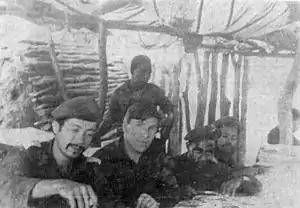| Part of a series on |
| War |
|---|
Unconventional warfare (UW) is broadly defined as "military and quasi-military operations other than conventional warfare"[1] and may use covert forces or actions such as subversion, sabotage, espionage, biowarfare, sanctions, propaganda or guerrilla warfare. This is typically done to avoid escalation into conventional warfare as well as international conventions.[2]

Description
Aside from the earlier definition of warfare that is not conventional, unconventional warfare has also been described as:
There is another type of warfare— new in its intensity, ancient in its origin—war by guerrillas, subversives, insurgents, assassins; war by ambush instead of by combat, by infiltration instead of aggression, seeking victory by eroding and exhausting the enemy instead of engaging him. It preys on unrest.[3]
Methods and organization
Unconventional warfare targets the civilian population psychologically to win hearts and minds, and only targets military and political bodies for that purpose, seeking to render the military proficiency of the enemy irrelevant. Limited conventional warfare tactics can be used unconventionally to demonstrate might and power, rather than to reduce the enemy's ability to fight substantially. In addition to the surgical application of traditional weapons, other armaments that specifically target the military can be used are: airstrikes, nuclear weapons, incendiary devices, or other such weapons.
Special Forces, inserted deep behind enemy lines, are used unconventionally to train, equip, and advise locals who oppose their government. They can also spread subversion and propaganda, while they aid native resistance fighters, to ultimately cause a hostile government to capitulate. Tactics focus on destroying military targets while avoiding damage to civilian infrastructure and blockading military resupply are used to decrease the morale of government forces.

The USA Department of Defense defines unconventional warfare as activities conducted to enable a resistance movement or insurgency to coerce, disrupt, or overthrow a government or occupying power by operating through or with an underground, auxiliary, and guerrilla force in a denied area.[4]
History
The advent of the Atomic Age changed forever philosophies of conventional warfare, and the necessity to conceal authorship of actions by hostile states. The age of asymmetric, or unconventional warfare & terrorism had begun.[5]
One of the first references is in "Manpower and Atomic War," [6] which Edward Fitzpatrick referred to as "the next kind of war- technological war, machine war, or atomic war."
Using soft power methods, to target civilians instead of military units, however had begun earlier, particularly as a strategy for use against Republics.[7] These were developed as a tool of national socialism,[8] or neo-liberalism,[9] and evolved into other doctrines.
There is an overlap in the world of Corporate Security & Defense Contracting where these models have extended to the field of Risk assessment.[10] One of the first instances of Unconventional Warfare techniques against civilians was documented by the La Follette Committee.
See also
- Asymmetric warfare
- Counterintelligence
- Gerasimov Doctrine
- Hybrid warfare
- Fourth generation warfare
- Full-spectrum dominance
- Irregular military
- Irregular warfare
- Low intensity conflict
- New generation warfare
- Partisan (military)
- Political warfare
- Psychological warfare
- Resistance movement
- Six-legged Soldiers
- Terrorism
- Total Resistance (book)
- Unrestricted Warfare
US & NATO specific:
References
- ↑ Nagao, Yuichiro (2001). "Unconventional Warfare: A Historical Perspective" (PDF). National Institute for Defense Studies. Ministry of Defense. Archived from the original (PDF) on 16 August 2022. Retrieved 18 August 2022.
- ↑ Fowler, Mike (4 November 2019). "The Rise of the Present Unconventional Character of Warfare". The Strategy Bridge. Archived from the original on 6 November 2019. Retrieved 18 August 2022.
- ↑ "U.S. Army Special Forces Unconventional Warfare Training Manual November 2010". U.S. ARMY. March 3, 2011.
- ↑ "Department of Defense Dictionary of Military and Associated Terms" (PDF). pp. JP 1-02. Retrieved 25 June 2019.
- ↑ "Timeline of the Office of Strategic Services (Record Group 226)". 15 August 2016. Retrieved August 7, 2021.
- ↑ Fitzpatrick, Edward A. (1951), Manpower and Atomic War, vol. 278, The Annals of the American Academy of Political and Social Science, p. 126-136 Also see: United States, President's Advisory Commission on Universal Training (29 May 1947), A program for national security, Washington, U.S. Govt. Print. Off., p. 14, OCLC 500618,
Second, and equal in importance to the first, we must have trained men in every part of our own country ready and able to meet disorder, sabotage, and even invasion.
- ↑ Paddock Jr., Alfred H., US Army Special Warfare, Its Origins: Psychological and Unconventional Warfare, 1941-1952, Minerva,
Carroll's study, forwarded to Draper on 24 February 1949, recommended that a separate "unit" be established to take charge of the Army's psychological warfare responsibilities.
; Wood, Gordon S. (1990), Classical republicanism and the American Revolution, vol. 13, Chi.-Kent L. Rev. 66,republicanism. . . offered new conceptions of the individual, the family, the state, and the individual's relationship to the family, the state, and other individuals.
- ↑ Pollock, Frederick (1941), Is National Socialism a new order?, vol. 9, Zeitschrift für Sozialforschung, p. 440-455
- ↑ Mayo, Elton (1966), The Social Problems of an Industrial Civilization, London: Routledge & Kegan
- ↑ Heath, R. L., Catalytic model of issues management. In Encyclopedia of public relations, vol. 1, SAGE Publications, Inc., p. 101; de Becker, G., Intervention decisions: The value of flexibility. White paper report prepared for the 1994 CIA Threat Management Conference